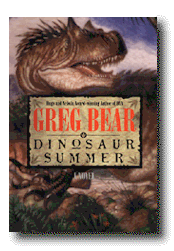 Dinosaur Summer
Dinosaur Summer
by Greg Bear
Warner Books, Inc.
New York, NY, 1998, 325p
ISBN 0-446-52098-5, $23.00 (US).
Reviewed by Martin Anderson,
1-H Gardenway, Greenbelt, MD 20770, USA.
It's a therapsid-eat-therapsid world that Greg Bear has given us atop El Grande, first brought to our notice in Arthur Conan Doyle's fantasy, The Lost World. There, Doyle introduced us to Professor George Edward Challenger, whose expedition into darkest Amazonia discovered the towering, slab-sided tepui or mesa that hosted, in splendid isolation, the world's last surviving population of dinosaurs.
In Doyle's more innocent, Edwardian days, that was not an unappealing conceit. Why, even in near-contemporary times, on windy nights when dark clouds scud across the moon, folks have been known to whisper of strange creatures said to exist beyond an impenetrable Congo swamp , or across a saw-toothed Papuan range, or perhaps in the unplumbed depths of some Pacific deep.
However, when those depths are plumbed, when we peer down beyond the swamp, or when we cross that range, the limits of our fantasies must again retreat to a more distant venue. All is not lost. If Sasquatch yet eludes us, the coelacanth still persuades that some mysteries may be secreted upon our green earth or beneath its blue seas. Unfortunately, our present experience surely teaches that which we seek in the here-and-now too often becomes mere fairy gifts fading away", in the words of Thomas Moore. With so many of life's greatest mysteries then buried by default in the distant past, what better reason is there to be a paleontologist?
Greg Bear, who would certainly agree, is a science fiction writer of considerable skill and attainment. Much of what he writes is memorable and always a good read. He has prepared himself thoroughly, acknowledging the advice and receiving here the praise of Dr. Philip Currie of the Royal Tyrell Museum. There is an imaginative fidelity to the world he portrays. There are also some extrapolations that, if they do not always persuade, do not detract from this excellent novel.
The story is set in the 1950's. Professor Challenger's long-ago discovery has ultimately culminated in Circus Lothar, which exhibits the last surviving dinosaurs recovered from El Grande. The intervening history has included a set of real and imaginary explorers, some, like Jimmy Angel and Colonel Percy Fawcett, associated with the region. Earlier off-stage assistance was provided by Presidents Coolidge and Hoover. At Circus Lothar, now near bankruptcy, the decision has been made to close down and return the beasts - including a centrosaur, a generic and very nasty theropod named Dagger, an ankylosaur, and some lesser creatures - to El Grande.
Among the real luminaries assembled at Circus Lothar in Boston are John Ringling North, John Ford, Ray Harryhausen, (still alive to praise the book), and the producers of King Kong, including the wealthy Merian Cooper, whom we shall meet again. Joining them are Anthony Belzoni, a National Geographic photographer, and his teen-age son Peter, until now a student at New York's George Edward Challenger High School, named for the great explorer, surely an appropriate prep school for the forthcoming adventure.
And a rousing adventure it is. The expedition is carefully planned and well-engineered. All the creatures are transported as securely as possible from circus to ship, by ship through the Atlantic to the Orinoco River, and up the river to Puerto Ordaz. Here the beasts in their cages are off-loaded to barges for further transport to the railroad at San Pedro de las Bocas and, from there, by train to a railhead within sight of El Grande.
Throughout, there are twin menaces looming. The theropod raptor Dagger - a horror with the eyes and charm of a basilisk - has been oozing a murderous, subliminal threat to all within view, his angry assaults threatening the integrity of his cage. Sharing the top of the food chain, the local Venezuelan military, barely obedient to the Caracas authorities, regards the outsiders of the expedition with unconcealed and uncooperative distaste.
The last leg, by truck, proceeds by dizzy switchbacks to the mile-high top of Pico Poco, an El Grande outlier, also discovered by Professor Challenger. During earlier years of exploration and collection, a counter-balanced steel swing bridge had been constructed to permit access from Pico Poco across the hundred-foot wide, mile-high chasm to the top of otherwise unclimbable El Grande.
Except for Dagger, the passage of all the animals to El Grande proceeds exactly as planned. With Dagger, a grand melee ensues when he finally escapes his cage. Peter and a few others, including the film crew, flee across to El Grande, while Dagger's weight collapses the span slowly enough for his escape back to Pico Poco. Injured, Dagger awaits certain execution by the panic-stricken Venezuelan soldiers.
Peter and his companions are trapped across the divide upon the mesa with its strange and deadly population. They see great and awful wonders and barely survive from one danger to another as they desperately await rescue. There is, of course the expected cast of Jurassic-Cretaceous fauna, to which Greg Bear has added his version of 65 million years worth of evolution.
One frightening new inhabitant is Stratoraptor, the gigantic, flightless, feathered death eagle, who is systematically exterminating the raptor population of El Grande. Save for an unhatched egg in an abandoned nest by a lake shore, poor unhappy Dagger would have had neither home nor relations to return to, had he survived.
Flying an amphibious PBY on loan from the U.S. Navy, Merian Cooper, of King Kong fame, arrives at a plesiosaur-stocked lake in the nick of time to rescue our lost party, their cameras, and their film as they struggle with a death eagle by the lake shore.
This grand story is profusely and dramatically illustrated by Tony DiTerlizzi. It is a wonderful book for an older child, perhaps of high school age, and certainly an entertaining one for readers of any age.
Copyright: Palaeontologia Electronica, 15 March 1999

